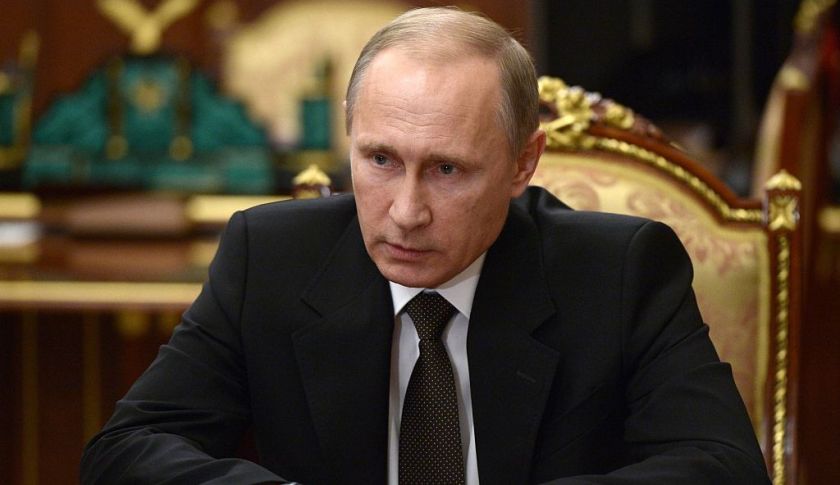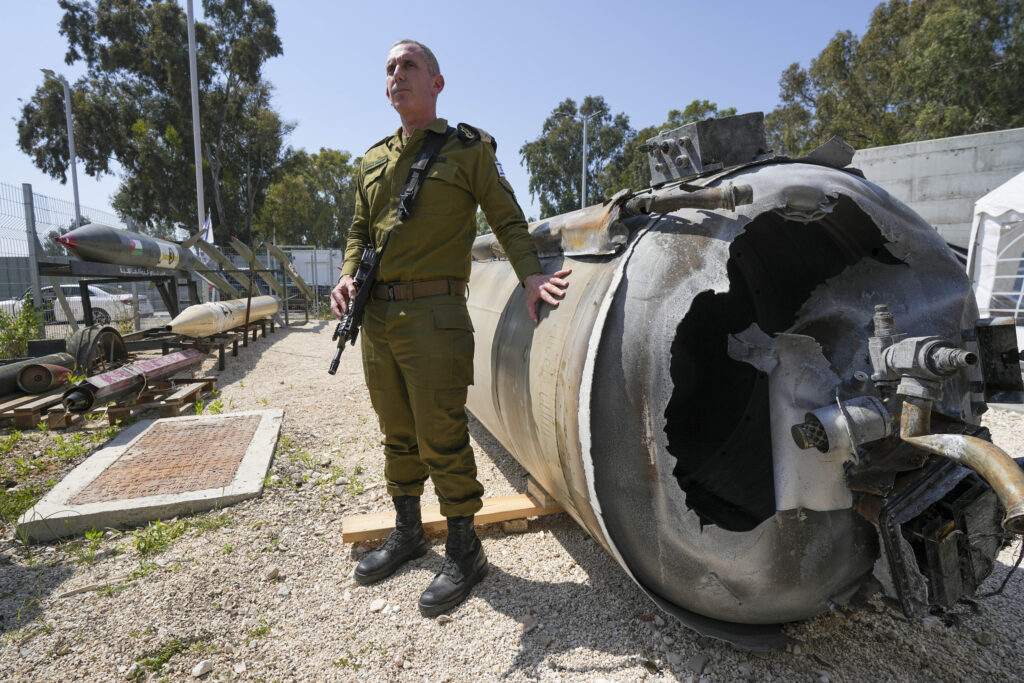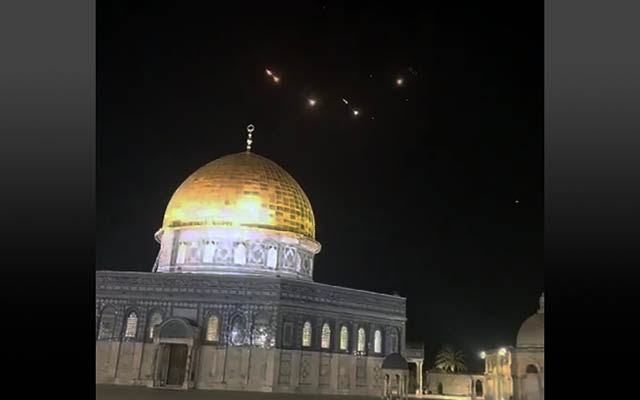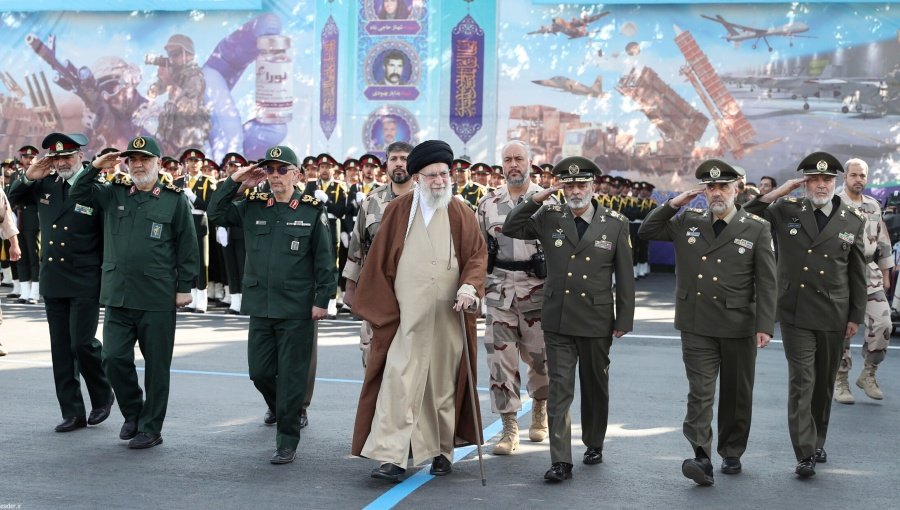UPDATES
Russia pulling out of Syria?
Mar 17, 2016

Update from AIJAC
March 17, 2016
Number 03/16 #04
Russian President Putin announced on Tuesday that Russia is pulling out the main part of Russias expeditionary force in Syria – but are keeping a key airbase and naval base. This Update is about the significance of the announced withdrawal, especially for Syria, and what was likely behind Putin’s decision to announce it now.
We lead with Washington Institute Russia expert Anna Borshchevskaya, who describes what Putin is doing as a facade, with it unclear how many forces will even be withdrawn given the retention of the Tartus naval facility and Hmeimim Air Base. She says that Putin’s claim to have largely achieved the objectives of the intervention makes little sense – the announced objective was to defeat ISIS, and Russia has not only not done that, but has concentrated most of its efforts on other rebels. She says the likely intention of the announcement is to strengthen Russia’s hand at the Geneva peacetalks, by playing the role of peacemaker, and thus force the US and rebels to make concessions to the Russian position there. For her full analysis, CLICK HERE. Another analysis of the possible explanations for Russia’s intentions comes from Aron Lund of the Carnegie Endowment for International Peace.
Next up is US strategic analyst Max Boot, who attempts to place this latest announcement within the context of an overall Russian strategic formula employed in Ukraine, Georgia and elsewhere. Boot says Putin is a master of maximising his gains while minimising his risks, and uses limited interventions to create “frozen conflicts” – situations where conflicts are unresolved but Russia remains an essential player in managing them. He says Putin will therefore want to try and preserve the current status quo in Syria – Assad in control of limited key areas of the country but unable to gain more – and the people of Syria will pay the price as the Syrian civil war drags on. For Boot’s complete discussion of Putin’s strategy, CLICK HERE.
Finally, Jonathan Spyer, in a piece written before Putin’s latest announcement, analyses the partial ceasefire that has been in place beforehand, since Feb. 27. While he say the ceasefire was a partial success – allowing humanitarian aid to some areas and reducing casualties – Spyer is pessimistic that any longer term peace will be possible. However he does raise the possibility that a precarious stability in a divided Syria may be possible if ISIS loses its base to the advancing US-backed Syrian Democratic Forces military alliance. Interestingly, Spyer also hinted at the possibility that Russia might soon declare it had achieved its aims and pull back from Syria. For this important look at the background in Syria to Putin’s announcement from a very knowledgeable observer, CLICK HERE. More on the Syrian ceasefire from Israeli academic experts Zvi Magen, Udi Dekel and Vera Michlin-Shapir.
Readers may also be interested in:
- Some Israeli expert views on the Russian withdrawal announcement. Plus, more on the effects on Israel from columnist Dan Margalit.
- A report that Russia will be leaving its ultra-modern S-400 air defence system to the Syrian regime when it pulls back.
- Elliott Abrams commemorates five years of disaster in Syria, as of Tuesday, with some horrifying statistics.
- An analysis of Iran’s arms buying spree from Russia.
- The Gulf Cooperation Council declares Hezbollah a terrorist organisation – as Matthew Levitt explains.
- Israeli Defence Minister Moshe Yaalon discusses Israel’s defence challenges in the wake of the Iran deal. More on the subject in an interview with Maj. Gen. (res.) Amos Gilad, Director of Policy and Political-Military Affairs at Israel’s Ministry of Defence.
- The International Atomic Energy Agency, in its latest report, announces that, in the wake of the nuclear deal, it is now more limited in what aspects of Iran’s nuclear program it can report on. Comment on the implications of this comes from Jonathan Tobin.
- Isi Leibler writes to urge a unity government in Israel to meet the threat on an unhelpful new US peace initiative reportedly being considered in Washington.
Russia’s Withdrawal Is Another Facade
Anna Borshchevskaya
Policy Alert, March 15, 2016
In addition to Moscow’s purposeful ambiguity about the true scope of its withdrawal from Syria, the announcement’s timing reflects Putin’s intention to force favorable terms in the latest peace talks.
As the Syrian peace talks resumed in Geneva this week, President Vladimir Putin announced a partial withdrawal of the “main part” of Russian armed forces as of March 15, according to the state-owned TASS news agency. Noting that the Defense Ministry had “on the whole” achieved its goals in Syria, Putin explicitly connected the withdrawal with the Geneva talks: “I hope that today’s decision will be a good signal for all conflicting sides. I hope that this significantly raises the confidence of all participants in the [peace] process.” He added that Russia’s Foreign Ministry would “intensify” its involvement in that process.
It is unclear exactly which forces will withdraw from Syria, particularly since Putin specified that Russia’s Tartus naval facility and Hmeimim Air Base will continue to operate as usual. The air base was established after Russia’s military campaign began last September, so it will certainly require Moscow to keep more forces in Syria than it had before the intervention, even if it does make good on its pledge to withdraw some units.
As for the notion that Moscow has achieved its goals in Syria, Putin has previously stated that the purpose of the intervention was to defeat the Islamic State (IS). But the group is obviously not defeated, and Moscow’s varying statements about the IS threat do not offer much clarity. On March 14, Defense Minister Sergei Shoigu claimed that Russia had destroyed over 2,000 “bandits” in Syria who had originated from Russia, including seventeen field commanders. Last year, however, the Kremlin justified the intervention in part with claims that 5,000-7,000 fighters from Russia had joined IS — and those claims themselves diverged drastically from earlier reports citing much lower figures. Besides the fuzzy numbers, Moscow’s decision to deploy troops to Syria may have increased the IS threat to Russia rather than decreased it; only time will tell, but the group has already targeted Russian civilians in apparent retaliation for the intervention (e.g., last October’s downing of a Russian passenger jet in Egypt was attributed to an IS cell).
More tellingly, the vast majority of Russia’s airstrikes in Syria have been against rebels fighting Bashar al-Assad’s regime, not against the Islamic State. Rescuing Assad from the rebellion and securing Russia’s interests — as Putin defines them — has been the real goal in Syria, and on that matter he can certainly claim success. The intervention has strengthened the regime’s position in the peace talks in Geneva, with Assad reportedly stating that Russian assistance helped him achieve “victories against terrorism” and stabilize the security situation. Both Assad and Putin define “terrorist” as any armed person who opposes the regime. Assad also noted that Russia will scale back its presence but keep some forces in place.
In broader terms, Putin’s seems to be laying the groundwork for casting himself as a “great world leader” — a peacemaker who successfully carried out a limited campaign with “minimum casualties,” then withdrew in order to lead international peace efforts. In doing so, he will undoubtedly seek to pressure both the United States and the Syrian opposition to stick with the Geneva process and more important, to make concessions that would benefit Putin above all else. The Russian language has a concept that best describes this situation: “pokazukha,” a facade or window dressing, something Putin knows all too well how to construct.
Anna Borshchevskaya is the Ira Weiner Fellow at The Washington Institute.
————————————————————————
Putin’s Formula for Destabilization
What does it mean that Vladimir Putin is withdrawing the main part of Russias expeditionary force in Syria? Its unclear because the words Putin uses are subject to interpretation and, in any case, he has repeatedly revealed himself to be as truthful as his number one American fan, Donald J. Trump. Putins announcement, which like all of his acts has caught Washington by surprise, can best be understood as a proclamation that he has achieved his basic goals in Syria and feels able to ramp down his commitment without ending it entirely.
And what are those goals? The ostensible justification for Russias involvement was to defeat ISIS. But less than 10 percent of Russian munitions have actually been targeted on the Islamic State. The rest have been reserved for more moderate rebels supported by the United States and our allies, for the simple reason that it is those rebels, and not ISIS, that pose the gravest threat to the survival of the Russian-Iranian client, Bashar Assad. Putin sent his aircraft and troops into Syria last fall because he did not want to risk seeing Assad toppled. But that does not mean that Putin is committed to achieving unconditional victory for Assad.
Putin is certainly enough of a realist to know that there is no way that Assad can, at acceptable cost, defeat his myriad enemies. Routing all of the insurgent factions in Syria, which include ISIS and the al-Nusra Front (an al-Qaeda affiliate), would require an Afghanistan-style invasion by Russia something that Putin has no appetite for. Indeed, the cost of staying committed in Syria even at the current levels was made clear this week when a rebel, shoulder-fired surface-to-air missile (reportedly an American-made Stinger) shot down a Russian-made MiG-21 flown by the Syrian air force. Russias Syria intervention has also further aggravated the international community, making it harder for European states and the U.S. to relax the sanctions they clamped on Russia after its invasion of Ukraine.
In his foreign adventures, Putin has revealed an impressive grasp of how to maximize his gains while minimizing his risk. In Ukraine, he has relied on proxy forces augmented by a relatively small number of ostensibly off-duty Russian soldiers (the little green men) backed up by Russian tanks and artillery. In Syria, he has relied on Iranian, and Assadist proxy forces backed up by Russian aircraft and a relatively small number of Russian troops. While President Obama has been afraid to get too involved in either Ukraine or Syria, making it impossible for the U.S. to achieve its basic aims in either country, Putin has delivered a master class in how to manage a military intervention smartly (if also immorally).
Part of Putins shrewdness is knowing when to be content with limited goals. In neither Ukraine in nor Syria has he pressed toward unconditional victory the inevitable American impulse. He has been content to extend and defend Russias sphere of influence while leaving the rest of both countries in other hands. In Syrias case, that means essentially leaving a patchwork of cantonments that are never likely to be reassembled into a unitary state. Assad and ISIS control large chunks of land on either side of Syria Assad in the east, ISIS in the west. The Kurds control a growing sphere of influence in the north the budding state of Rojava along the Turkish border. In the north, around Aleppo, and in the south, around Daraa, various rebel groups hold sway. No individual group is able to rule the entire country. And while that may be a tragedy to Syrian patriots, to Putin it is an opportunity to be exploited.
The Russian autocrat specializes in creating frozen conflicts. In Georgia, Moscow supports the breakaway territories of Abkhazia and South Ossetia; in Moldova, Transnistria; in Ukraine, the renegade provinces of Luhansk and Donetsk along with the now-annexed Crimea. Add to these the Assad state in Syria which controls a narrow strip of territory in the east running from Damascus to Latakia along the Mediterranean coast, which is home to a Russian airbase that looks to be a permanent fixture. Putins goal in peace talks in Geneva will perpetuate this status quo indefinitely. As long as Assad retains at least this much authority, Russia will be able to project power into the Middle East and stymie American efforts to (in Moscows thinking) dominate the region.
It goes without saying that this also means the continuance of a terrible tragedy for the Syrian people as well as nearby states. A civil war that may already have killed nearly half a million people, and made millions more into refugees, will continue and terrible tyrants such as Assad and ISIS will continue to rule a substantial part of Syrias territory. But Putin couldnt care less. As long as Russia appears powerful, he is satisfied, in no small part because power projection outside his territory spun into a glorious military victory by the compliant, Kremlin-controlled media helps him to keep power within Russia. You can almost see why Trump admires Putin so much: Putin does appear strong (the highest term of praise in the Donalds lexicon) compared to Obama, who once again looks weak. Only if you inject considerations of morality (as alien to Trump as to Putin) would you realize that Putin is hardly an admirable leader or a model worth emulating.
Back to Top
————————————————————————
Will the Syrian Ceasefire Last?
by Jonathan Spyer
The Jerusalem Post, March 13, 2016
The cease-fire that came into effect in Syria on February 27 is a partial success. Humanitarian convoys have begun to get through to some of the areas besieged by government forces.
The death toll is sharply down. According to the Syrian Observatory for Human Rights, the civilian death toll in Syria fell by 90 percent last week. This was accompanied by an 80% decline in deaths among combatants on all sides.
“Proximity” talks between the sides are set to commence in Geneva on Wednesday. The government has announced it will attend. The opposition High Negotiations Committee has yet to make a final decision but will probably also be there.
So does the cease-fire in Syria represent the beginnings of an endgame in the long and bloody civil war that has racked the country since mid- 2011? This is a war in which, according to a recent report by the Damascus-based Syrian Center for Policy Research, up to 470,000 people have died. Fully 11.5% of the population have been killed or injured, and 45% have left their homes.
As of now, there remains very little chance of the implementation of the plan as outlined in Vienna last November for the diplomatic process in Syria. According to this plan, within six months of the commencement of negotiations, the sides are to establish a “credible, inclusive, and nonsectarian” transitional government. This government will then set about drafting a new constitution and holding free and fair UN-supervised election within 18 months.
The tentative success of the February 27 cease-fire notwithstanding, this plan still sounds utterly unrealistic. Its main stumbling block remains the core disagreement between regime and opposition over the future role of President Bashar Assad. For the opposition, any role for Assad in the course of the transition remains utterly unacceptable.
For Assad, riding high on the results of the Russian intervention that began last September, there is no reason to compromise or contemplate departure. On the contrary, the Syrian dictator bullishly (and absurdly) announced this week that parliamentary elections will take place across Syria on April 13.
Since the officially sanctioned diplomatic process remains somewhat otherworldly, and yet the cease-fire has not been a total failure, what direction are events likely to take? As of now, Syria has fragmented, and a host of related conflicts are taking place over its ruins. The Russian intervention has effectively removed from the table the possibility of the military destruction of the dictatorship.
For this to be achieved, an air force capable of besting that of the Russians, who guarantee Assad’s survival, would need to enter the fray. Such air power is possessed only by the US. Washington has absolutely no intention of acting as the air wing of the Syrian Sunni rebels, in a way analogous to that of the Russians vis-à-vis the regime.
Since this is likely to remain the case, it follows that there is no longer any credible military threat to the continued existence of the Assad regime in its enclave in Damascus, in the western coastal area, in the cities of western Syria and in the areas linking them.
This being said, it remains the case that a regime reconquest of the entirety of Syria also remains unlikely. Assad, in a recent interview, declared this to be his goal. But it is unlikely that the actual forces that could conceivably achieve this goal for him Russian air power and Iranian proxies on the ground are interested in pursuing it.
Iran is withdrawing Iranian Revolutionary Guard Corps personnel from northwest Syria. The immediate goal of preventing any threat to the regime has been achieved. The Iranian regime does not appear to wish to commit its own forces to the mutual slaughterhouse that a campaign to reconquer all of rebel and Sunni jihadist-controlled Syria would entail.
The Russians, too, appear wary of a long and grinding campaign of reconquest. With a devalued ruble and very low oil prices, it is not clear that they could sustain the necessary expenditure.
Again, the goal of the Russian campaign appears to have been to preserve the regime enclave, not to enter an all-out assault for the reunification of Syria by military means.
Even Assad himself may be aware that an attempt at reunifying the country under his rule would bring back the original dilemma that caused his withdrawal in the first place. Assad does not possess sufficient forces to securely govern those areas that reject his rule. The Russian intervention has not altered this core reality.
Russia wants to see the removal of Ukraine-related sanctions on it, and to be treated as a world power. Backing its allies and ensuring their survival forms a part of this. An ongoing bloody campaign of reconquest is unlikely to do so.
So if the disparate rebellion can’t beat Assad, and if Assad is unlikely to achieve or even try for a knockout blow against the rebellion, and if there is no basis for a negotiated settlement, doesn’t that mean that the diplomacy is doomed, the cease-fire bound to be short-lived, and a return to full-blown conflict inevitable?
Maybe, but not necessarily. It is worth remembering that there are two other vital players on the Syrian map, apart from the Assad regime and the Sunni Arab rebellion. The two other elements are the Kurds, and Islamic State. As of now, a Western-backed military alliance, the Syrian Democratic Forces, is making steady headway against Islamic State. If this progress can continue, the prospect opening up in Syria will be for a Russian-guaranteed, Assad-ruled west, and a US-guaranteed east, in which Islamic State has either been destroyed or is in the process of eclipse.
On this basis, with neither side able to dislodge the other and neither side having an obvious interest in continued conflict (or with each side deterred by inescapable realities if they do), it is possible to imagine the beginning of a diplomatic process based on the emergence of a confederal or de facto divided Syria.
Such an outcome is, of course, not certain, but it is possible. If it does not emerge, the bloodletting in Syria is likely to recommence with full force in the future, and the current cease-fire to be remembered as little more than a brief respite.
Jonathan Spyer is director of the Rubin Center for Research in International Affairs and a fellow at the Middle East Forum.
Tags: Russia











